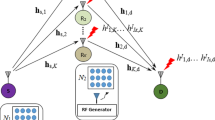Abstract
This article is focused on secure relay beamformer design with a correlated channel model in the relay-eavesdropper network. In this network, a single-antenna source-destination pair transmits secure information with the help of an amplify-and-forward (AF) relay equipped with multiple antennas, and the legitimate and eavesdropping channels are correlated. The relay cannot obtain the instantaneous channel state information (CSI) of the eavesdropper, and has only the knowledge of correlation information between the legitimate and eavesdropping channels. Depending on this information, we derive the conditional distribution of the eavesdropping channel. Two beamformers at the relay are studied for the approximate ergodic secrecy rate: (1) the generalized match-and-forward (GMF) beamformer to maximize the legitimate channel rate, and (2) the general-rank beamformer (GRBF). In addition, one lower-bound-maximizing (LBM) beamformer at the relay is discussed for maximizing the lower bound of the ergodic secrecy rate. We find that the GMF beamformer is the optimal rank-one beamformer, that the GRBF is the iteratively optimal beamformer, and that the performance of the LBM beamformer for the ergodic secrecy rate gets close to that of the GRBF for the approximate secrecy rate. It can also be observed that when the relay has lower power or the channel gain of the second hop is low, the performance of the GMF beamformer surpasses that of the GRBF. Numerical results are presented to illustrate the beamformers’ performance.
Similar content being viewed by others
References
Barkat, M., 2005. Signal Detection and Estimation. Artech House.
Chen, L., 2011. Physical layer security for cooperative relaying in broadcast networks. Military Communications Conf., p.91–96. http://dx.doi.org/10.1109/MILCOM.2011.6127796
Cheng, X., Wang, C., Wang, H., et al., 2012. Cooperative MIMO channel modeling and multi-link spatial correlation properties. IEEE J. Sel. Areas Commun., 30(2): 388–396. http://dx.doi.org/10.1109/JSAC.2012.120218
Choi, J., 2016. A robust beamforming approach to guarantee instantaneous secrecy rate. IEEE Trans. Wirel. Commun., 15(2): 1076–1085. http://dx.doi.org/10.1109/TWC.2015.2482494
Csiszár, I., Korner, J., 1978. Broadcast channels with confidential messages. IEEE Trans. Inform. Theory, 24(3): 339–348. http://dx.doi.org/10.1109/TIT.1978.1055892
Dong, L., Han, Z., Petropulu, A.P., et al., 2010. Improving wireless physical layer security via cooperating relays. IEEE Trans. Signal Process., 58(3): 1875–1888. http://dx.doi.org/10.1109/TSP.2009.2038412
Ferdinand, N.S., da Costa, D.B., de Almeida, A.L.F., et al., 2014. Physical layer secrecy performance of TAS wiretap channels with correlated main and eavesdropper channels. IEEE Wirel. Commun. Lett., 3(1): 86–89. http://dx.doi.org/10.1109/WCL.2013.112313.130733
Geraci, G., Al-Nahari, A.Y., Yuan, J., et al., 2013. Linear precoding for broadcast channels with confidential messages under transmit-side channel correlation. IEEE Commun. Lett., 17(6): 1164–1167. http://dx.doi.org/10.1109/LCOMM.2013.050313.130353
Ghose, S., Bose, R., 2013. Power allocation strategy using node cooperation for transmit power minimization under correlated fading. National Conf. on Communications, p.1–5. http://dx.doi.org/10.1109/NCC.2013.6487960
Kim, A.Y., Cho, H.N., Lee, J.W., et al., 2009. Allocation of transmit power in spatially-correlated dual-hop MIMO relay channels. 9th Int. Symp. on Communications and Information Technology, p.332–336. http://dx.doi.org/10.1109/ISCIT.2009.5341231
Kobayashi, M., Caire, G., 2007. Joint beamforming and scheduling for a multi-antenna downlink with imperfect transmitter channel knowledge. IEEE J. Sel. Areas Commun., 25(7): 1468–1477. http://dx.doi.org/10.1109/JSAC.2007.070919
Krikidis, I., 2010. Opportunistic relay selection for cooperative networks with secrecy constraints. IET Commun., 4(15): 1787–1791. http://dx.doi.org/10.1049/iet-com.2009.0634
Lee, J.H., 2015. Cooperative relaying protocol for improving physical layer security in wireless decode-and-forward relaying networks. Wirel. Pers. Commun., 83(4): 3033–3044. http://dx.doi.org/10.1007/s11277-015-2580-2
Leung-Yan-Cheong, S., Hellman, M.E., 1978. The Gaussian wire-tap channel. IEEE Trans. Inform. Theory, 24(4): 451–456. http://dx.doi.org/10.1109/TIT.1978.1055917
Li, J., Petropulu, A.P., Weber, S., 2011. On cooperative relaying schemes for wireless physical layer security. IEEE Trans. Signal Process., 59(10): 4985–4997. http://dx.doi.org/10.1109/TSP.2011.2159598
Luo, Z., Ma, W.K., So, A.M.C., et al., 2010. Semidefinite relaxation of quadratic optimization problems. IEEE Signal Process. Mag., 27(3): 20–34. http://dx.doi.org/10.1109/MSP.2010.936019
Magnus, J.R., Neudecker, H., 1988. Matrix Differential Calculus with Applications in Statistics and Econometrics. Wiley.
McKay, M.R., Collings, I.B., 2005. General capacity bounds for spatially correlated Rician MIMO channels. IEEE Trans. Inform. Theory, 51(9): 3121–3145. http://dx.doi.org/10.1109/TIT.2005.853325
Tulino, A.M., Lozano, A., Verdu, S., 2005. Impact of antenna correlation on the capacity of multiantenna channels. IEEE Trans. Inform. Theory, 51(7): 2491–2509. http://dx.doi.org/10.1109/TIT.2005.850094
Wang, X., Wang, K., Zhang, X., 2013. Secure relay beamforming with imperfect channel side information. IEEE Trans. Veh. Technol., 62(5): 2140–2155. http://dx.doi.org/10.1109/TVT.2012.2230657
Wang, X., Su, Z., Wang, G., 2015. Relay selection for secure backscatter wireless communications. Electron. Lett., 51(12): 951–952. http://dx.doi.org/10.1049/el.2014.4401
Wyner, A.D., 1975. The wire-tap channel. Bell Syst. Techn. J., 54(8): 1355–1387. http://dx.doi.org/10.1002/j.1538-7305.1975.tb02040.x
Yin, X., Cheng, X., 2016. Propagation Channel Characterization, Parameter Estimation, and Modeling for Wireless Communications. Wiley-IEEE Press.
Yuan, Z., Chen, C., Bai, L., et al., 2016. Secure relay beamforming with correlated channel models in dualhop wireless communication networks. IEEE GLOBECOM, p.1–6. http://dx.doi.org/10.1109/GLOCOM.2016.7842252
Zhang, M., Wen, M., Cheng, X., et al., 2016. A dual-hop virtual MIMO architecture based on hybrid differential spatial modulation. IEEE Trans. Wirel. Commun., 15(9): 6356–6370. http://dx.doi.org/10.1109/TWC.2016.2583423
Zhang, R., Cheng, X., Yang, L., 2016a. Cooperation via spectrum sharing for physical layer security in device-todevice communications underlaying cellular networks. IEEE Trans. Wirel. Commun., 15(8): 5651–5663. http://dx.doi.org/10.1109/GLOCOM.2015.7417724
Zhang, R., Cheng, X., Yang, L., 2016b. Joint power and access control for physical layer security in D2D communications underlaying cellular networks. IEEE Int. Conf. on Communications, p.1–6. http://dx.doi.org/10.1109/ICC.2016.7511531
Author information
Authors and Affiliations
Corresponding authors
Additional information
Project supported by the National Natural Science Foundation of China (Nos. 61471008, 61571020, and 61622101) and the National Key Research and Development Project of China (No. 2016YFE0123100)
ORCID: Zhen-hua YUAN, http://orcid.org/0000-0003-3619-4831
Rights and permissions
About this article
Cite this article
Yuan, Zh., Chen, C., Cheng, X. et al. Correlated channel model-based secure communications in dual-hop wireless communication networks. Frontiers Inf Technol Electronic Eng 18, 796–807 (2017). https://doi.org/10.1631/FITEE.1700023
Received:
Revised:
Accepted:
Published:
Issue Date:
DOI: https://doi.org/10.1631/FITEE.1700023




